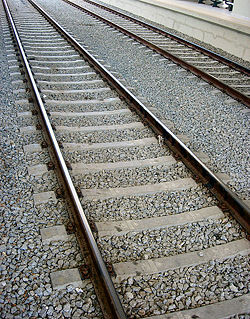Parallel (geometry)
Jump to navigation
Jump to search

Railroad tracks must be parallel to each other or else the train will come off the track like this one in Portugal.
Parallel (symbolized by two adjacent vertical lines ∥) are two lines on a flat plane that never meet. Two geometric entities are said to be parallel if they do not intersect if projected to infinity. More than one element may be parallel to any number of other elements, which would all be parallel to one another.
Thus two lines are parallel if they do not cross at any point on a flat plane. Similarly two planes are said to be parallel if they do not intersect at any line.
The following demonstrates parallel lines:
If a line AB is parallel to CD and AB is parallel to EF then CD is parallel to EF
The following demonstrates parallel planes:
If a plane ABC is parallel to DEF and ABC is parallel to GHI then ABC is parallel to GHI